Corals and Coral Reefs
Coral reefs are one of the most diverse ecosystems on the planet. Corals are small animals related to jellyfish (Figure 1). Large groups of these animals live together and form huge interconnected colonies (Figure 2). Many corals have a special relationship with a type of single-celled algae. The algae live inside the coral's body and produce most of their host's food through photosynthesis. Coral reefs are often found in shallow, tropical seas where these algae have enough sunlight to make food. The algae also give the coral its color—a healthy coral is typically yellow to brown (Figures 1 and 2). Using energy from the algae, some corals form reefs by building an external skeleton from a mineral called calcium carbonate. These reefs are an essential habitat for a wide variety of animal and plant species.
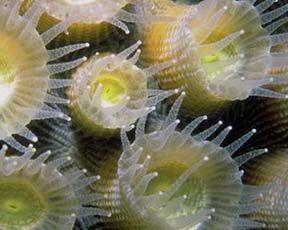
Credit: Wikimedia Commons
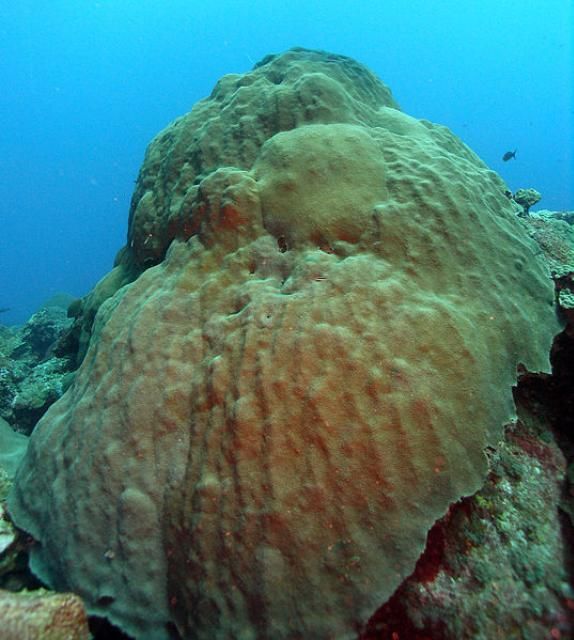
Credit: Wikimedia Commons
Coral reefs benefit people in many ways. Globally,
- about 400 million people rely on coral reef fish as a source of protein (Cinner 2014).
- about 6 million people make a living by catching and selling coral reef fish and invertebrates (Cinner 2014).
- tourism activities like SCUBA diving and snorkeling provide revenue of US$9.6 billion per year (Cesar, Burke, and Pet-Soede 2003).
- reefs reduce wave energy by 97%, helping to protect 197 million people in coastal areas from beach erosion, wave energy and flooding (Ferrario et al. 2014).
The largest coral reef in the United States is located in southeast Florida. Florida's reef creates 70,000 local jobs (Johns et al. 2013), and its residents enjoy each of the benefits listed above.
Despite their high value, the future of coral reefs is currently in jeopardy. Recent studies have shown that many reefs worldwide have lost 50–90% of live coral over the past 30–40 years (Baker 2014). Corals are dying worldwide as a result of multiple stressors, many of them human-induced (Pandolfi 2003). Conservation and restoration of coral reef habitats are key to their future and the future of nations that depend on them, including the United States. An important part of any conservation effort must be to reduce or eliminate the stressors that are causing reefs to become degraded. This article will outline some of the major threats to coral reefs and the strategies that everyone, whether living one mile or one thousand miles from a coral reef, can use to help reduce negative impacts on these ecosystems and preserve their services for years to come.
Threat: Climate Change
One of the main stressors facing coral reefs is climate change. Burning fossil fuels results in the release of carbon dioxide (CO2), much of which accumulates in the atmosphere or is absorbed by the ocean. In the atmosphere, CO2 traps heat from the sun after it is reflected off the planet's surface. This results in the warming of the entire planet, including the oceans. This process is called the "greenhouse effect." When oceans become warmer than usual, reef-building corals can lose the important algae that live within their tissues and give them their color and most of their food. When this occurs, the coral becomes stark white, leaving it with a "bleached" appearance (Figure 3). This phenomenon, known as coral bleaching, has become more common over time (Hoegh-Guldberg 1999). Bleaching is expected to happen more often as oceans continue to warm (Fabina, Baskett, and Gross 2015). Although a coral can sometimes recover, bleaching often leads to death (Wilkinson 1998).
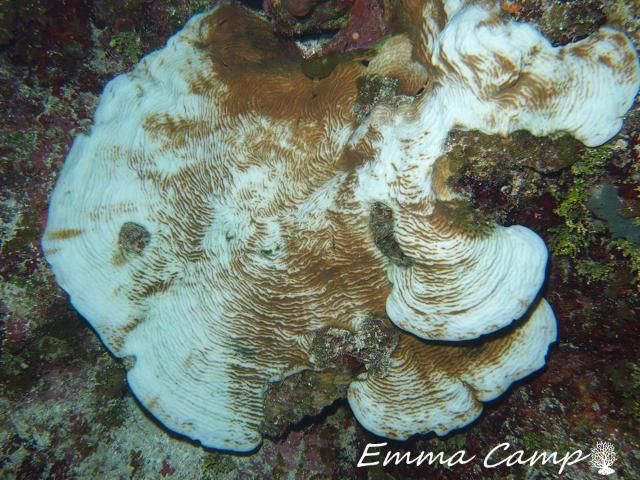
Credit: Dr. Emma Camp, University of Technology Sydney
When the ocean absorbs CO2, a different process called ocean acidification occurs (Raven et al. 2005). The ocean currently absorbs about half of the CO2 produced by the burning of fossil fuels and other human activities (Sabine et al. 2004). Carbon dioxide dissolves in water to form carbonic acid. Carbonic acid decreases the pH of the ocean and makes it more acidic. A more acidic ocean poses numerous problems for coral reef species that use calcium carbonate to build their skeletons. These species include some algae, clams, crabs, lobsters, and corals. The change in the ocean's chemistry makes it increasingly difficult for many of these organisms to form skeletons, grow, and reproduce (Hoegh-Guldberg et al. 2007). As the oceans' chemistry changes to make their environment less hospitable, reefs may have trouble surviving and growing.
How you can help:
- Reduce your use of fossil fuels.
Consider fuel economy when shopping for a new car. Cars, trucks, vans, and other types of automobiles have become more fuel-efficient over time thanks to advances in engineering. New technologies could increase the fuel economy of midsize passenger cars to 53 mpg by 2025 (Chase 2014).
You may also be able to cut down on how often you drive. Carpooling, walking, biking, or using public transportation when possible can help reduce your use of fossil fuels and save you money. Even something as simple as planning ahead to complete your errands in one trip instead of many throughout the week can help lower your impact.
You can also lower your energy use at home, especially if your electricity comes from fossil fuels like coal. At home, make sure you don't leave your lights or electronics on when they are not in use. If you use an air conditioner, turn it off when you leave the house. Planting shade trees on your property is a great way to work with nature to save on cooling costs (Escobedo, Seitz, and Zipperer 2009). Ensuring your walls, windows, and doors are tightly sealed and insulated can also help reduce wasted energy. Energy-efficient appliances and low-energy light bulbs are also widely available for purchase. UF/IFAS Extension offers a helpful series on improving energy efficiency in your home at https://edis.ifas.ufl.edu/entity/topic/series_energy_efficient_homes, and you can visit your local UF/IFAS Extension office for additional resources on planting shade trees and energy efficiency.
Many more easy tips for lowering your climate change impact at home, at school, at the office, and on the road are available at https://www.epa.gov/climate-change/what-you-can-do-about-climate-change. The coral reefs—and your wallet—will thank you for taking the time to make these easy switches!
2. Eat locally when possible.
An indirect way to reduce your fossil fuel use is to eat local produce, meat, and dairy products. A typical meal in the United States contains ingredients from an average of five different countries (Natural Resources Defense Council 2007). Buying locally grown and raised foods reduces the amount of fossil fuel used for shipping and helps support your community. Consider finding a farmer's market near your home or signing up for a Community Supported Agriculture (CSA) program, in which fresh foods from local farms are delivered straight to your door. Resources to help locate farmer's markets and CSA opportunities in Florida are available on the Florida Department of Agriculture and Consumer Services' website: https://www.fdacs.gov/Food-Nutrition/Buy-Fresh-From-Florida.
You can take local eating one step further by starting your own vegetable garden! UF/IFAS Extension has published a series of guides for setting up your own vegetable garden in Florida, including information on produce varieties that grow best in Florida's climate: https://edis.ifas.ufl.edu/entity/topic/lawn_and_garden. You can also contact your county's UF/IFAS Extension office for help getting your garden started.
Threat: Coastal Runoff and Pollution
Most of the pollution that enters the ocean originates on land. Development along shorelines releases sediment into coastal waters. Sediment can smother adult corals and stop young corals from growing new colonies. Fertilizer runoff from land also pollutes water. It can increase the amount of algae, which can overgrow coral and lead to coral disease. In addition, fertilizer runoff can lower the amount of oxygen in coastal waters. This creates "dead zones" where marine life cannot live, hurting the ecosystem and harming local fisheries. Sewage runoff can also occur as a result of outdated waste systems. This can introduce harmful microorganisms that cause coral disease (Sutherland et al. 2010). Finally, solid garbage, especially discarded fishing gear, can injure or kill coral.
How you can help:
- Reduce or adjust your fertilizer use.
The same nutrients in fertilizer that help to grow lawns also help to grow harmful algae when rain washes them into the ocean. Even if you don't live on the coast, you may still be adding unwelcome fertilizer into the ocean. Fertilizer enters the ocean through runoff into upland streams, canals, or storm drains. For this reason, fertilizer runoff is often worse during the rainy summer months. Some Florida counties have ordinances in place that regulate the amount and type of fertilizer you can use and the time of year you can use it. You can find out if your county is one of them at https://tbep.org/our-work/education/be-floridian/. Be Floridian and UF/IFAS Extension also provide resources for creating Florida-friendly landscaping. Florida-friendly landscaping uses native plants that need less fertilizer, pesticides, and water. Because of this, these plants save you time and money and help keep excess fertilizer out of the ocean. See https://edis.ifas.ufl.edu/entity/topic/ffl for additional information on creating environmentally friendly outdoor spaces in Florida. Contact your local UF/IFAS Extension office for more tips and resources.
2. Limit use of plastics and be sure to reuse, recycle, and properly dispose.
Garbage enters the ocean mainly through littering and poor waste management. Because of their light weight, plastics are often blown into the environment. Only 10% of everything we throw away is plastic, but plastic makes up a whopping 80% or more of the litter we find in nature (Barnes et al. 2009). Be sure to always properly dispose of any waste, especially plastic, in a secure container where it will not be blown away.
One way to reduce pollution in the ocean, including on coral reefs, is by curbing personal use of plastics. This is especially true for single-use plastics like straws, plastic cutlery, and grocery bags (Jambeck et al. 2015). Try taking your drink without a straw, keeping a set of reusable cutlery at work, or asking restaurants not to include plastic utensils when you order takeout. Consider trying reusable grocery bags instead of the plastic variety. Plastic bags do not readily decompose and can harm marine life. Keeping reusable bags by the door or in your car can help you remember to bring them to the grocery store.
Finally, help keep garbage on shorelines (Figure 4) out of the ocean by participating in a local beach, river, or roadside cleanup. Helping with the plastic problem can also be as simple as bringing a spare bag along to collect litter on your next walk! Contact your local UF/IFAS Extension office for more information and to find local cleanup events in your area.
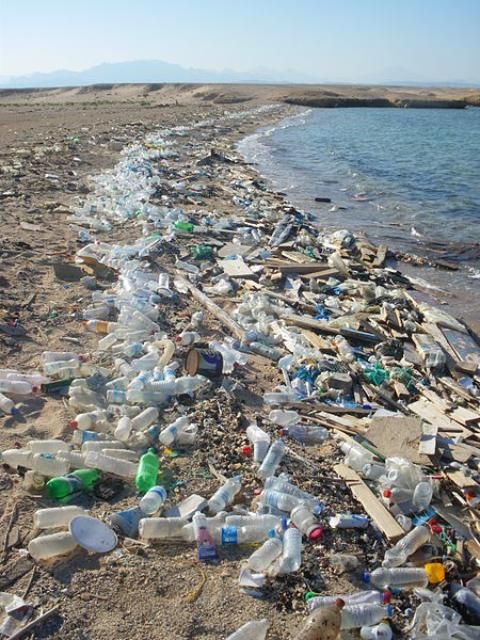
Credit: Wikimedia Commons
3. Leave nothing behind when diving, snorkeling, or fishing.
Most people know that sea turtles, birds, and marine mammals are often harmed when they get trapped in ocean garbage. Just like other marine animals, corals get injured when they are tangled up in trash! Preventing the loss of fishing gear in the first place is cheaper, easier, and more effective than trying to clean it up after it is lost, so keep a close eye on your depth when fishing to avoid hooking coral. Divers and snorkelers can enjoy the reef while helping to protect it by participating in a reef clean up. Many dive shops organize reef clean up trips. Find out more at https://floridadep.gov/rcp/coral or call your local dive shop.
Threat: Overfishing
Many coral reefs are threatened by overfishing (Jackson et al. 2014). Fish are important to the overall balance of the coral reef ecosystem. For example, overfishing top coral reef predators like sharks can affect the entire food chain (Figure 5). Without sharks to control their numbers, populations of smaller predators can increase. This can lead to declines in prey species, like smaller fish that control the growth of seaweed. Too much seaweed is bad for corals, which can be quickly overgrown. Sharks are especially vulnerable to overfishing because they have a long life span. They also grow and reproduce slowly. That means that it can take many years for a new shark to replace one that is removed from the environment by fishing. On some reefs, the effects of overfishing top predators like sharks are intensified by the direct removal of parrotfish and other herbivores. Parrotfish are important grazers of seaweed. When parrotfish are overfished, seaweed can quickly overgrow vast areas of once-vibrant reef.
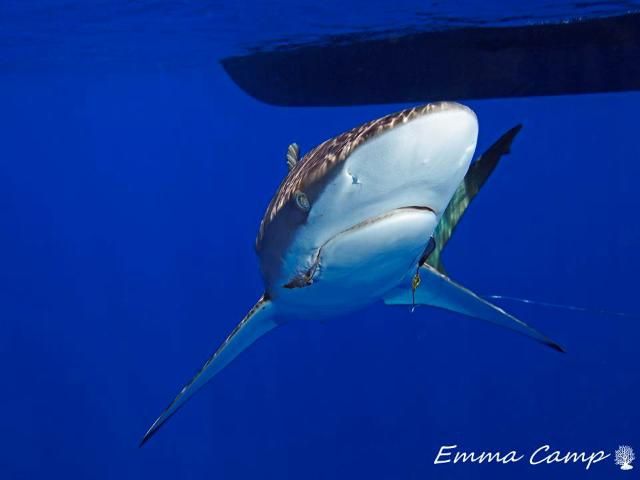
Credit: Dr. Emma Camp, University of Technology Sydney
Coral reefs are also threatened in many areas of the world by fishing methods that are destructive to corals. This includes dynamite fishing and cyanide fishing, among others. Dynamite and cyanide fishing have been banned in many areas across the globe, but are still used illegally (Bailey and Sumaila 2015). These destructive practices are used to harvest species both for food and for home aquaria. How you can help:
- Choose your seafood and pets wisely.
Protect corals by choosing your seafood wisely. If parrotfish is offered on a menu on your next vacation, say no! Also, try choosing alternatives to large coral reef predators like sharks.
Similarly, take up good home aquarium habits. Know where your ornamental fish and invertebrates come from. When possible, opt for sustainably farmed rather than wild-caught organisms (Figure 6). For more information on sustainable aquaculture in the ornamental fish industry, see https://www.risingtideconservation.org/. UF/IFAS Extension also provides additional resources for responsible aquarium ownership at https://edis.ifas.ufl.edu/entity/topic/aquaria.

Credit: Tyler Jones, UF/IFAS
2. Know your marine park and fishing laws.
Marine protected areas are tools used to preserve marine resources in an area by preventing certain activities that can harm marine life (NOAA 2015). Some types of marine protected areas, known as "no-take reserves," are closed to fishing and take of marine life. Although this may seem strict, these reserves areas can actually help fisheries by increasing the number of fish in fished areas. These reserves help by encouraging migration of adults into fished areas, and by preserving breeding adults, which supply new juvenile fish (Francini-Filho and Moura 2008; Harrison et al. 2012). In areas where fishing is allowed, some fish and invertebrate species may have special rules like catch or size limits to help prevent overfishing.
Strategies like marine protected areas and fishing limits only work if people follow the rules. Help to conserve marine resources (and avoid hefty fines), by knowing the law before you head out on the water. Find out more about US marine protected areas at https://marineprotectedareas.noaa.gov/. For Florida fishing regulations and species-specific guidelines (including printer-friendly charts), visit https://myfwc.com/fishing/.
3. Do not catch or harm herbivores.
Reefs overgrown with seaweed are bad for corals, fish, and divers. Although the harvest of parrotfish is not prohibited in Florida, crossing them off your personal list of fished species is a decision the coral reefs will thank you for! In Florida and the Caribbean, the long-spined sea urchin (Figure 7) was another important grazer of algae on coral reefs. Their numbers declined dramatically following a disease outbreak in the 1980s. Scientists believe this was a major factor in the decline in coral reef health across Florida and the Caribbean. Although they are no longer abundant, some divers and snorkelers still consider the long-spined sea urchin a nuisance because of its sharp spines. If you spot these important critters while diving or snorkeling, please do not disturb them.
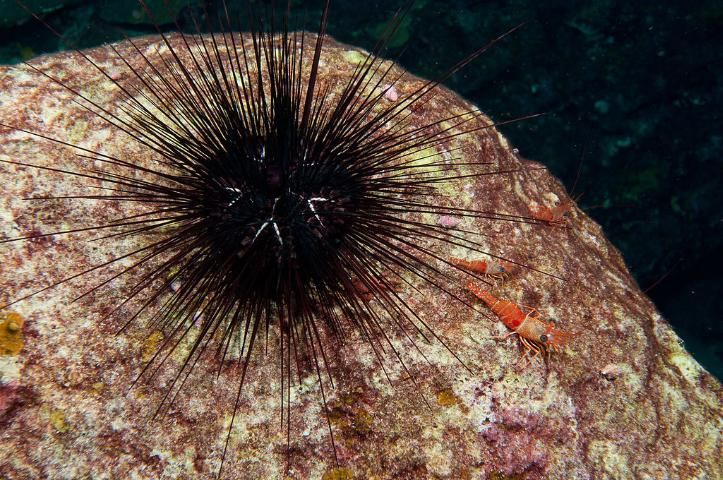
Credit: Wikimedia Commons
Threat: Physical Damage
In addition to the threats outlined above, corals are still regularly harmed by direct physical damage by humans. Carelessly dropped anchors are a common way corals are broken. Similarly, high frequency of recreational diving activities has been shown to contribute to degradation of reefs through coral breakage, lacerations, and sedimentation. One study showed that although many divers care about coral reefs, 97% of divers in the Florida Keys came into direct contact with the reef during their dives as a result of fin kicks, loose equipment, and deliberate touches (Camp and Fraser 2012).
How you can help:
- Keep your hands and gear off the reef.
Accidental reef contact usually occurs due to fixable problems such as improperly secured gear and poor buoyancy control. Learn reef etiquette: the dos and don'ts of diving! Find a handy checklist at https://floridakeys.noaa.gov/onthewater/etiquette.html. If it's been a few years since your last dive, take a pool-based refresher course to practice your skills before hitting the reef. Even experienced divers can benefit from a specialty certification in buoyancy, which is offered by multiple dive certification associations. You'll be safer and more comfortable on your dive and more likely to avoid run-ins with coral. Contact your local dive shop to learn more.
If you're diving in a warm climate, consider ditching the gloves! Gloves have been shown to make divers more likely to grab the reef underwater (Camp and Fraser 2012). If you must use gloves, keep your arms crossed during your dive—you'll improve your buoyancy skills and be less tempted to touch (Figure 8).
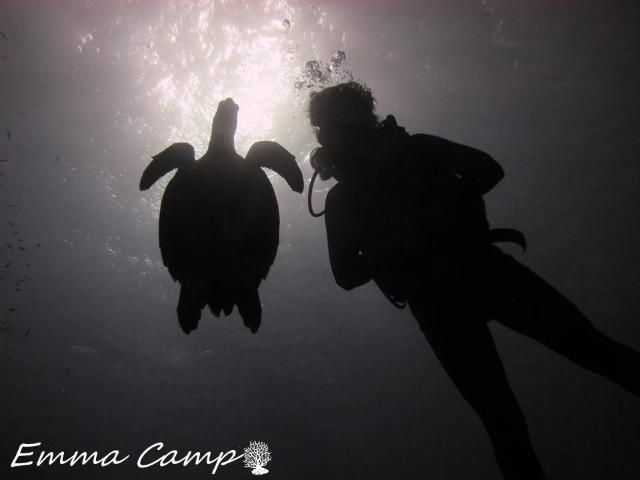
Credit: Dr. Emma Camp, University of Technology Sydney
2. Do not collect souvenirs from the reef.
By now you know that corals are animals, not rocks! Unfortunately, it is still common in some areas for people to remove coral, shells, or other objects from the reef to take as a souvenir. Leave these items on the reef. Even shells that look empty could have small animals inside or serve as future homes. When it comes to coral reefs, always remember to look and not touch. If you see a fellow diver collecting souvenirs or disturbing the reef, ask them to stop or inform your captain or dive leader.
3. Choose sustainable dive operations.
Choose a dive operator that is committed to marine sustainability. In the Florida Keys, NOAA has implemented the Blue Star program to identify these dive and snorkel operators. Blue Star operators make sure that visitors practice good reef etiquette and provide dive briefings that will help divers to learn more about coral reefs. Look for a Blue Star operator at https://sanctuaries.noaa.gov/bluestar/operators.html.
4. Use mooring bouys instead of anchoring when possible.
Mooring buoys are commonly installed to allow boaters to secure their vessels at popular dive and snorkel locations on Florida's coral reefs. They are free to use in the Florida Keys National Marine Sanctuary, are safer and easier than anchoring, and allow boaters to rest assured that they have not damaged coral with an anchor. For tips on using mooring buoys and to see a map of mooring buoy locations in the Florida Keys National Marine Sanctuary, check out https://floridakeys.noaa.gov/mbuoy/howto.html.
Most of us would like to leave coral reefs in a better state than we found them, but we cannot adopt reef-friendly practices if we don't know about them. Consider sharing your knowledge with your friends and family. Many people don't know about the importance of coral reefs, the threats to their continued existence, or ways to reduce these threats. It is up to us to ensure that the oceans are protected, not only to conserve the animals and plants they support, but also to preserve our own lifestyles and livelihoods. This article has briefly outlined some of the most significant threats to coral reefs and some of the ways you can help to protect them, whether you're out on the water daily, or have never been to the ocean. The tools, strategies, and resources in this document can be used to promote actions that will help to conserve our coral reefs for years to come.
References
Bailey, M., and U. R. Sumaila. 2015. "Destructive fishing and fisheries enforcement in eastern Indonesia." Mar. Ecol. Prog. Ser. 530, 195–211.
Baker, A. 2014. "Climate Change: Many Ways to Beat the Heat for Reef Corals." Curr. Biol. 24, R1166–R1168.
Barnes, D. K. A., F. Galgani, R. C. Thompson, and M. Barlaz. 2009. "Accumulation and fragmentation of plastic debris in global environments." Philos. Trans. R. Soc. Lond. B. Biol. Sci. 364, 1985–1998.
Camp, E., and D. Fraser. 2012. "Influence of conservation education dive briefings as a management tool on the timing and nature of recreational SCUBA diving impacts on coral reefs." Ocean Coast. Manag. 61, 30–37.
Cesar, H., L. Burke, and L. Pet-Soede. 2003. The Economics of Worldwide Coral Reef Degradation. Cesar Environmental Economics Consulting, Arnhem.
Chase, N. 2041. Significant fuel economy improvement options exist for light-duty gasoline vehicles. U.S. Department of Energy, Washington, D.C..
Cinner, J. 2014. "Coral reef livelihoods." Curr. Opin. Environ. Sustain. 7, 65–71.
Escobedo, F., J. A. Seitz, and W. Zipperer. 2009. The Effect of Gainesville's Urban Trees on Energy Use of Residential Buildings. Gainesville: University of Florida Institute of Food and Agricultural Sciences. https://edis.ifas.ufl.edu/publication/FR273.
Fabina, N. S., M. L. Baskett, and K. Gross. 2015. "The differential effects of increasing frequency and magnitude of extreme events on coral populations." Ecol. Appl. 25, 1534–1545.
Ferrario, F., M. W. Beck, C. D. Storlazzi, F. Micheli, C. C. Shepard, and L. Airoldi . 2014. "The effectiveness of coral reefs for coastal hazard risk reduction and adaptation." Nat. Commun. 5, 1–9.
Francini-Filho, R. B., and R. L. Moura. 2008. "Evidence for spillover of reef fishes from a no-take marine reserve: An evaluation using the before-after control-impact (BACI) approach." Fish. Res. 93, 346–356.
Harrison, H. B., D. H. Williamson, R. D. Evans, G. R. Almany et al. 2012. "Larval Export from Marine Reserves and the Recruitment Benefit for Fish and Fisheries." Curr. Biol. 22, 1023–1028.
Hoegh-Guldberg, O. 1999. "Climate change, coral bleaching and the future of the world's coral reefs." Mar. Freshw. Res. 50, 839–866.
Hoegh-Guldberg, O., P. J. Mumby, A. J. Hooten, R. S. Steneck, P. Greenfield, E. Gomez, C. D. Harvell, et al. 2007. "Coral reefs under rapid climate change and ocean acidification." Science 318, 1737–1742.
Jackson, J., M. Donovan, K. Cramer, and V. Lam (eds). 2014. Status and Trends of Caribbean Coral Reefs: 1970–2012. Global Coral Reef Monitoring Network, IUCN, Gland.
Jambeck, J. R., R. Geyer, C. Wilcox, T. R. Siegler, M. Perryman, A. Andrady, R. Narayan, and K. L. Law. 2015. "Plastic waste inputs from land into the ocean." Science 347, 768–771.
Johns, G., C. Kelble, D. Lee, V. Leeworthy, and W. K. Nuttle. 2013. Ecosystem Services Provided by the South Florida Coastal Marine Ecosystem. MARES Whitepaper: Ecosystem Services.
NOAA. 2015. "What is a marine protected area?" Natl. Ocean Serv. at https://oceanexplorer.noaa.gov/facts/mpas.html
Natural Resources Defense Council. 2007. Food miles: How far your food travels has serious consequences for your health and the climate. New York. https://goodfoodworld.com/wp-content/uploads/2012/10/foodmiles.pdf
Pandolfi, J. M. 2003. "Global Trajectories of the Long-Term Decline of Coral Reef Ecosystems." Science 301, 955–958.
Raven, J., K. Caldeira, H. Elderfield, O. Hoegh-Guldberg, P. Liss, U. Riebesell, J. Shepherd, C. Turley, and A. Watson. 2005. Ocean acidification due to increasing atmospheric carbon dioxide. The Royal Society: London.
Sabine, C., R. A. Feely, N. Gruber, R. M. Key, J. L. Bullister, R. Wanninkhof, et al. 2004. "The Oceanic Sink for Anthropogenic CO2." Science 305, 367–371.
Sutherland, K. P., S. Shaban, J. L. Joyner, J. W. Porter, and E. K. Lipp. 2010. "Human sewage identified as likely source of white pox disease of the threatened Caribbean elkhorn coral, Acropora palmata." Environ. Microbiol. 12, 1122–1131.
Wilkinson, C. 1998. "The 1997–1998 Mass Bleaching Event Around the World." In: Status of Coral Reefs of the World, 1998. Global Coral Reef Monitoring Network, Australian Institute of Marine Science, Townsville.